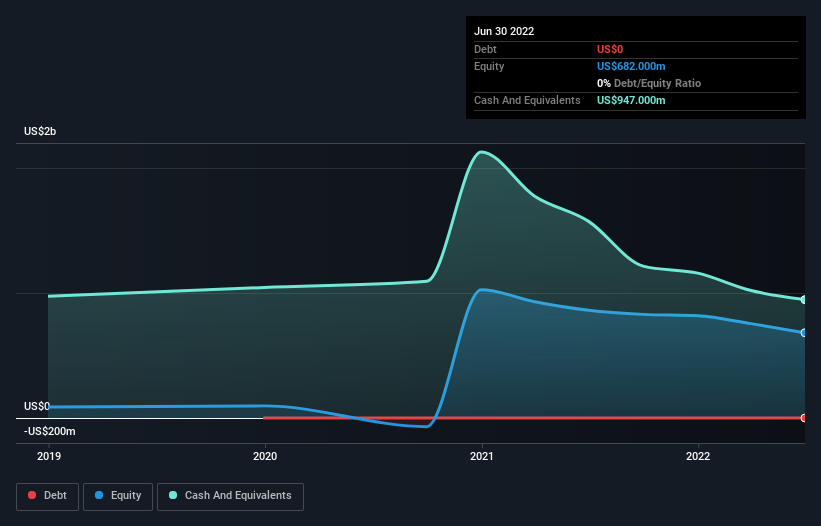- United States
- /
- General Merchandise and Department Stores
- /
- NasdaqGS:LOGC
ContextLogic (NASDAQ:WISH) Will Have To Spend Its Cash Wisely

Even when a business is losing money, it's possible for shareholders to make money if they buy a good business at the right price. For example, although Amazon.com made losses for many years after listing, if you had bought and held the shares since 1999, you would have made a fortune. Having said that, unprofitable companies are risky because they could potentially burn through all their cash and become distressed.
So should ContextLogic (NASDAQ:WISH) shareholders be worried about its cash burn? For the purposes of this article, cash burn is the annual rate at which an unprofitable company spends cash to fund its growth; its negative free cash flow. The first step is to compare its cash burn with its cash reserves, to give us its 'cash runway'.
View our latest analysis for ContextLogic
Does ContextLogic Have A Long Cash Runway?
A cash runway is defined as the length of time it would take a company to run out of money if it kept spending at its current rate of cash burn. As at June 2022, ContextLogic had cash of US$947m and no debt. Looking at the last year, the company burnt through US$609m. That means it had a cash runway of around 19 months as of June 2022. Importantly, analysts think that ContextLogic will reach cashflow breakeven in 3 years. That means unless the company reduces its cash burn quickly, it may well look to raise more cash. You can see how its cash balance has changed over time in the image below.

How Well Is ContextLogic Growing?
It was fairly positive to see that ContextLogic reduced its cash burn by 42% during the last year. But it makes us pessimistic to see that operating revenue slid 65% in that time. Taken together, we think these growth metrics are a little worrying. While the past is always worth studying, it is the future that matters most of all. For that reason, it makes a lot of sense to take a look at our analyst forecasts for the company.
How Easily Can ContextLogic Raise Cash?
Even though it seems like ContextLogic is developing its business nicely, we still like to consider how easily it could raise more money to accelerate growth. Companies can raise capital through either debt or equity. Commonly, a business will sell new shares in itself to raise cash and drive growth. By looking at a company's cash burn relative to its market capitalisation, we gain insight on how much shareholders would be diluted if the company needed to raise enough cash to cover another year's cash burn.
ContextLogic has a market capitalisation of US$522m and burnt through US$609m last year, which is 117% of the company's market value. That suggests the company may have some funding difficulties, and we'd be very wary of the stock.
How Risky Is ContextLogic's Cash Burn Situation?
On this analysis of ContextLogic's cash burn, we think its cash burn reduction was reassuring, while its cash burn relative to its market cap has us a bit worried. One real positive is that analysts are forecasting that the company will reach breakeven. After looking at that range of measures, we think shareholders should be extremely attentive to how the company is using its cash, as the cash burn makes us uncomfortable. An in-depth examination of risks revealed 4 warning signs for ContextLogic that readers should think about before committing capital to this stock.
Of course ContextLogic may not be the best stock to buy. So you may wish to see this free collection of companies boasting high return on equity, or this list of stocks that insiders are buying.
New: AI Stock Screener & Alerts
Our new AI Stock Screener scans the market every day to uncover opportunities.
• Dividend Powerhouses (3%+ Yield)
• Undervalued Small Caps with Insider Buying
• High growth Tech and AI Companies
Or build your own from over 50 metrics.
Have feedback on this article? Concerned about the content? Get in touch with us directly. Alternatively, email editorial-team (at) simplywallst.com.
This article by Simply Wall St is general in nature. We provide commentary based on historical data and analyst forecasts only using an unbiased methodology and our articles are not intended to be financial advice. It does not constitute a recommendation to buy or sell any stock, and does not take account of your objectives, or your financial situation. We aim to bring you long-term focused analysis driven by fundamental data. Note that our analysis may not factor in the latest price-sensitive company announcements or qualitative material. Simply Wall St has no position in any stocks mentioned.
About NasdaqGS:LOGC
Flawless balance sheet minimal.
Similar Companies
Market Insights
Community Narratives



